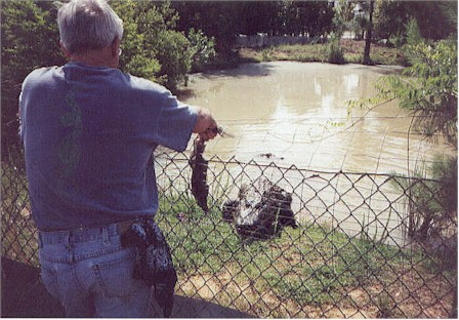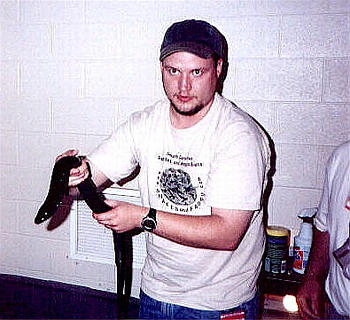Savannah River Site Trip '00
from
Norman Hicks
on
December 31, 2000
View comments about this article!
SREL Field Trip 2000
By Norman Hicks
Eleven members of our society visited the Department of Energy's Savannah River Site (SRS) on May 20 as the guests of Dr. Whit Gibbons of the University of Georgia's Savannah River Ecology Laboratory (SREL). In attendance were Chris Harper, Johnny Hester, Justin Gosnell, Gene Ott, Winn Ott, Mardi Snipes, Adam Grayson, Walter Kidd, Todd Kokko, Dr. Bob Herrington and myself. The Savannah River Site represents a unique opportunity for field herpers as its 310 square miles have seen limited human disturbance during the last fifty years due to its use as a nuclear weapons material processing facility. The vast majority of this acreage serves simply as a buffer zone and is undeveloped. The landscape includes sand hill uplands and river swamps, as well as depressional wetlands known as Carolina Bays. The difference in land use between SRS and the surrounding areas is so profound that the boundaries of the site are clearly delineated in infrared photographs taken by satellite. Ecological research at the site has been ongoing since 1951, shortly after the site was created by the Atomic Energy Commission. In short, this place is a herper's paradise.
After mustering at the lab's main offices, we offered a sacrifice (a DOR squirrel) to the lab's unofficial mascot, Stumpy, a rather largish alligator kept in one of the research ponds. All attempts to elicit a bellow from him in response to our best attempts to mimic a gator's roar failed, but I'm sure he found our efforts quite comic. Perhaps if we feed him better next year, we'll have better luck herping. Dr. Gibbons also introduced us to an alligator snapping turtle which has been residing at the lab for a number of years. After examining the pond where John Lee (one of Whit's grad students) had studied the winter ecology of cottonmouths by placing temperature-sensing radio transmitters in them, we were primed to hit the woods and see what we could find.

Conditions were extremely dry and the temperature was already in the 90's as we flipped cover boards and sheets of roofing tin at our first stop. Captured were a southeastern crowned snake (Tantilla coronata) and a black racer (Coluber constrictor). Since we had found a pigmy rattlesnake (Sistrurus miliarius) at this site last year, our next stop was at a stand of longleaf pine with a known population of pigmies. They evaded our sweep of the area, although another black racer was found. While we were eating lunch at Carolina Barbecue in New Ellenton, we consoled ourselves with the knowledge that pigmies are difficult to spot, since their pattern makes them almost indistinguishable from the pine cones which littered the forest floor.
Rejuvenated, we investigated a dehydrated cypress/tupelo swamp adjacent to Upper Three Runs Creek while Dr. Gibbons took another tour group on a canoe excursion on the creek itself. Before he parted from us, he borrowed a pillowcase "in case I catch a rainbow snake". We somewhat inadvertently split into two groups while exploring the area, with one group heading up the road to an artesian spring while the other went down the road to a small reservoir. Four cottonmouths (Agkistrodon piscivorus) were spotted and two of them captured. Other sightings included a redbelly water snake (Nerodia erythrogaster), a brown water snake (N. taxispilota) and two more alligators. When Dr. Gibbons returned from his canoe ride, he had the promised rainbow snake (Farancia erytrogramma) in the borrowed bag.

We concluded our visit to SREL by examining the extensive herp collection that the lab maintains for outreach and public education programs. Perhaps the showcase of this collection is their amelanistic canebrake rattlesnake (Crotalus horridus), but the hypomelanistic cottonmouth has to be a close second. Other favorites included the eastern indigo (Drymarchon corais couperi) and southern hognose (Heterodon simus). We finally got to see a handsome little pigmy rattler as well. All-in-all, it was an excellent trip, but 310 square miles is a bit much to cover in one day. I guess the rest will have to wait until next year.

The author wishes to thank Gene Ott and Chris Harper for helping him remember what he did and who he did it with. For a more detailed account of these events, see Gene's field notes at.:
www.snakesandfrogs.com/scra/notes/notes05.htm
Norman Hick's is a Masters Degree candidate in Wildlife Ecology and Management at the University of Georgia.
|
RE: Savannah River Site Trip '00
|
Reply
|
|
by Charper on August 13, 2002
|
Mail this to a friend!
|
We will probably go back in the Spring of 2003. I was going to shoot for Fall 2002, but it looks like the calendar is full.
CH
|
| |
|
Email Subscription
You are not subscribed to discussions on this article.
Subscribe!
My Subscriptions
Subscriptions Help
Other Field Notes Articles
 The Spring Egress: Moments with Georgia’s Denning Horridus
The Spring Egress: Moments with Georgia’s Denning Horridus
 Bushmasters and the Heat Strike
Bushmasters and the Heat Strike
|

